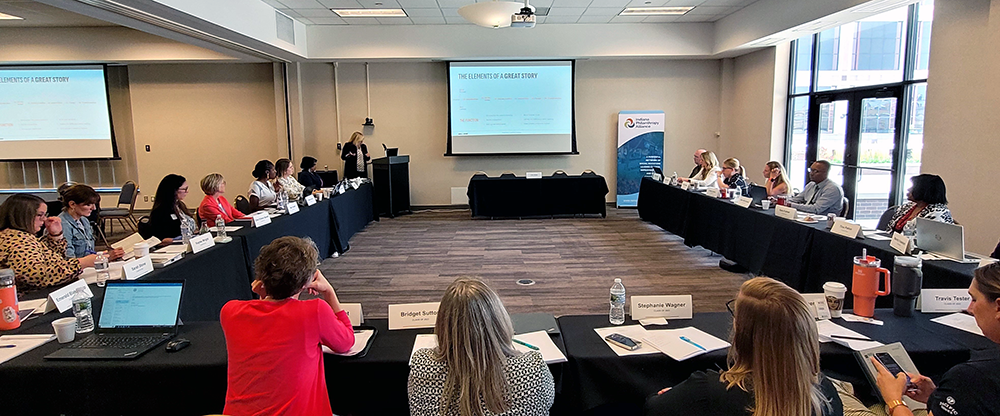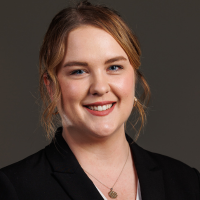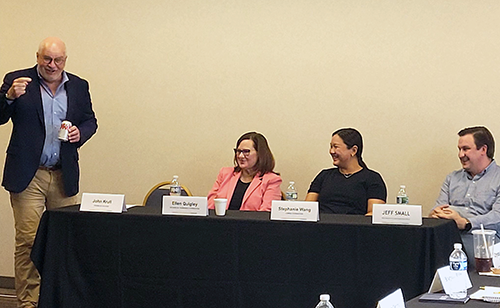Value of Storytelling Conveyed in July Mutz Session

This blog was written by Alexandra Pflug, former executive director of Fayette Community Foundation, to provide an inside look into her Mutz Philanthropic Leadership Institute class.
“Shaping the Message,” the July 18 Mutz Institute session at Regions Tower, provided valuable insights into the evolving world of news coverage and storytelling. Attendees gained a deeper understanding of journalism's changing landscape and philanthropy's critical role in supporting media organizations.
The day commenced with an insightful panel discussion on the changing landscape of news coverage and its impact on philanthropic organizations. John Krull, director of Franklin College’s Pulliam School of Journalism, moderated a thought-provoking discussion with Holly Hays (The Indianapolis Star), Milicent Emery (Western Wayne News), and Lindsey Erdody (Axios.)
The panelists addressed the decline in news coverage due to shrinking resources and staff. They acknowledged the rise of smaller outlets with different business models—such as nonprofits—filling the void in some areas.
With fewer resources, many news outlets are increasingly focused on analytics to cater to what people are likelier to read—but this greatly affects which stories receive coverage. The changing audience has influenced their work. They advised organizations in the room to understand what their intended impact is to tell their stories more effectively.The second panel—also moderated by Krull and including Ellen Quigley (Richard M. Fairbanks Foundation), Stephanie Wang (Lumina Foundation), and Jeff Small (Nina Mason Pulliam Charitable Trust)— delved into the strategies employed by philanthropic organizations to support journalism.
Panelists highlighted the importance of funding journalism to build awareness and provide in-depth reporting on societal issues. They stressed the benefits of philanthropy's involvement, enabling a stronger connection between grantmakers and grantees, resulting in more diverse and trustworthy stories. They also acknowledged the challenges of measuring the impact of philanthropy in journalism and the evolving funding models' effect on reporting quality.
While there was a general consensus that philanthropy could (and possibly should) have a role, the group addressed possible unintended impacts of philanthropy in journalism, given that nonprofits and grantmakers have a mutually beneficial need for local journalism to be successful (so our stories can be told effectively).
Questions were asked about how to ensure transparency in grantmaking toward this cause. Participants pondered less direct ways of supporting journalism that could pass more intense scrutiny, such as supporting media literacy education and access to local journalism in classrooms.
Lisa Vielee of Well Done Marketing led an engaging afternoon workshop on the art and science of storytelling to effectively convey their message. It emphasized storytelling’s value to educate, create connections, and drive action.
Vielee brought down the elements of a great story and their function:- Introduction - Personalize the source material.
- Set the stakes - Build connection and create relevance.
- Journey/Conflict - Set up the need and cause for action.
- Intervention - Showcase the organization's work and approach.
- Change - Illustrate the difference being made.
- Transformation - Give reason to believe and inspire action.
The workshop encouraged tailoring stories to meet the audience's needs and wants, utilizing emotional appeals, and educating on processes to gain trust. Participants crafted compelling stories and discussed the importance of maintaining a culture of journalism starting from an early age.
The training session left attendees feeling empowered to use the power of storytelling to drive their missions forward and contribute to a more informed, connected, and compassionate society. In the end, participants learned we are all storytellers in our own ways.



